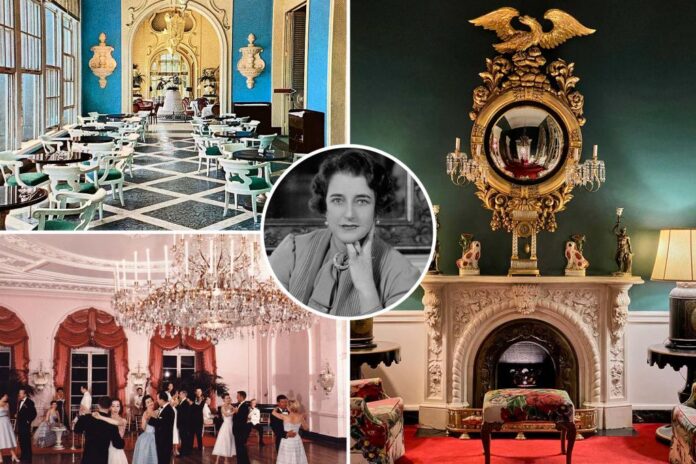Gilded Age heiress, groundbreaking entrepreneur and visionary decorator Dorothy Draper blazed a trail in the 1930s for both women and the interior design profession.
Raised amongst society’s upper crust in Tuxedo Park, NY, she bucked tradition by going into business for herself as a divorcee and infusing the day’s drab interiors with bright, cheerful colors and bold mixed patterns for an aesthetic that became known as modern baroque.
In a fully revised deluxe edition to his 1988 biography, “The Draper Touch: The High Life and High Style of Dorothy Draper” (Shannongrove Press), Carleton Varney, Draper’s successor at Dorothy Draper & Company, chronicles the life and times of “the duchess of decorating.”
Set against the backdrop of two world wars and the Great Depression, Draper’s tumultuous era can sometimes feel familiar today. “[She] conveyed a glamorous, bright and cheerful attitude,” writes Varney, “despite the chaotic and dark times.”
Out today, the book dazzles with more than 100 archival photographs and illustrations.


Draper was born in 1889 into the New York upper crust society immortalized by Edith Wharton’s Gilded Age novels. The daughter of iron heir Paul Tuckerman and shipping heiress Susan Minturn, she grew up in Tuxedo Park, 40 miles north of New York City, where society retreated in the spring and fall. The Tuckermans built no fewer than three homes in Tuxedo Park, including Stoneleigh Hall in 1928 designed by architect Frederick Foster with its immense stone façade and stately turrets. Draper would go on to design interiors influenced by the era’s grandeur, yet reject its bland color palettes, which she described as “gravy.”


Her marriage to Dr. Dan Draper, President Franklin Roosevelt’s personal doctor, ended in 1930 at the height of the Great Depression. One of her first breaks as a decorator was the Carlyle Hotel where she eventually took an apartment for herself. Soon, a slew of hotel, nightclub and real estate commissions followed, including Fefe’s of Monte Carlo, a club on Madison Avenue at 54th Street. It was an early showcase of Draper’s signature touch — an exuberant color palette of yellow and green, reflective walls, vertical stripes, black lacquer finishes and cream upholstery — as illustrated in this 1930s postcard above.


Draper’s professional heyday corresponded with the challenges of World War II.
Confronted by the draft, luxury fabric shortages and the potential collapse of her industry, she was approached in 1942 with a seemingly quixotic commission, the Palácio Quitandinha resort and casino in Rio de Janeiro, a $10 million project that would become South America’s largest hotel. Draper’s $30,500 fee would also break records as the highest commercial decorating contract signed to date. Situated on 3,000 acres with a domed casino that dwarfed St. Peter’s Basilica and 500 rooms with 15-foot ceilings, the massive scale suited Draper’s maximalist bravado.
Her color palette of sky blue, sunshine yellow and jungle green was drawn from Brazil’s natural landscape, while her bold floral patterns covered furnishings, wallpaper and window treatments, and her signature black-and-white checkered floors were blown up to an exaggerated scale.


The Greenbrier Hotel in White Sulphur Springs, W.Va., is widely considered Draper’s masterpiece and greatest design legacy. The 1770s-era resort was converted into diplomatic lodging and later an army hospital during World War II. In 1948, Draper was tasked with restoring the grand dame to its former glory. In this contemporary photo of the resort’s upper lobby, the spirit of Draper’s designs are intact, with its “Jefferson” blue walls, floral pattern sofas and original black marble fireplace and checkered floors. Today, the Greenbrier remains a treasured retreat for the moneyed milieu.


In this archival photo of the Greenbrier’s Cameo Ballroom, a massive chandelier epitomizes Draper’s favored Louis XIV edict of “nothing small.” The same can be said of the celebrities that flocked to the reopened resort in the 1940s and 50s, which included the Duke and Duchess of Windsor, John F. Kennedy and Bob Hope.




Draper’s final project was Westinghouse’s Dorothy Draper Dream Home of the Future for the 1964 World’s Fair in New York City.
Soon after, she sold her company to Varney who has carried on her legacy for nearly six decades.
She died in 1969 at age 79 from complications of Alzheimer’s disease. But her maximalist flare lives on through her influence on contemporary designers, from Kelly Wearstler to Corey Damen Jenkins.
These renderings from Westinghouse’s promotional catalogue illustrate Draper’s hallmark touch: bright floral patterns, bold stripes, graphic flooring and saturated color.
Credit: Source link

















